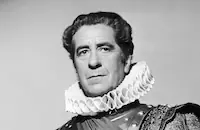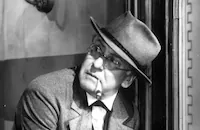Impact

Brief Synopsis
Cast & Crew
Arthur Lubin
Brian Donlevy
Ella Raines
Charles Coburn
Helen Walker
Anna May Wong
Film Details
Technical Specs

Synopsis
After delivering a passionate speech in which he convinces his company's board of directors to purchase some factories in Tahoe, California, San Francisco industrialist Walter Williams returns home to his wife Irene. Walter reenacts part of the speech for Irene, and their maid, Su Lin, mistakes it for an argument. Walter then leaves to finalize the deal, promising to call Irene on his way home. After Walter leaves, Irene phones her lover, Jim Torrence, with whom she is plotting to kill Walter, and tells him to go to Sausalito. When Walter phones Irene, she persuades him to give her cousin "Jim," who is stranded in Sausalito, a ride to his home in Denver. Walter meets Torrence and they drive for several hours before stopping at a café. While Walter is inside, Torrence sabotages one of Walter's tires. When the later tire blows, they stop near a steep embankment. Torrence then hits Walter on the head with a wrench, rolls his unconscious body down the slope and tosses his briefcase after him. Just then, a passing moving-van driver stops to offer help, and a panicked Torrence drives off and crashes head-on into a tanker truck full of fuel.
Meanwhile, Walter regains consciousness, grabs his briefcase, climbs back up to the road and jumps into the back of the moving-van, then passes out. Later, in San Francisco, police lieutenant Tom Quincy informs Irene that Walter has been killed in the crash, as Torrence's charred remains have been mistaken for Walter's. Irene attempts to find Torrence, who was supposed to meet her at an Oakland hotel after he had killed Walter. After attempting to phone Torrence's aunt in Denver, Walter realizes that he has been set up. The moving-van men later find Walter's briefcase in their truck and turn it over to the police, who check it for fingerprints and find Torrence's. Quincy then locates Torrence's residence in Berkeley and finds monogrammed handkerchiefs identical to one he saw Irene use. Checks of phone bills reveal many calls between Irene and Torrence. Quincy informs Irene that Walter's briefcase has been found and that they now suspect foul-play. Walter decides to stay on in Larkspur, the small Idaho town where he has landed, and gets a job as a mechanic in a gas station run by war widow Marsha Peters. Marsha's mother invites Walter, who now goes by the name Bill Walker, to board with them. There, Walter keeps a collection of newspaper clippings about the case and learns that the police are searching for Irene's lover.
Three months later, Walter has settled down in Larkspur and started to develop a relationship with Marsha. When news comes that Irene has been charged with conspiring to kill Walter and that the police are still hunting Torrence, Walter is content to let Irene take the blame. Several weeks later, Marsha's mother accidentally finds the collection of clippings, but trusts him and says nothing to her daughter. To avoid involving Marsha, Walter decides to leave and tells her about his past, but she convinces him to return to San Francisco and goes with him to substantiate his story to the police, who confront Irene with Walter. Irene quickly accuses Walter of killing Torrence, claiming that she and Walter argued after he refused to give her a divorce, a fact that Su Lin can verify. The police decide to hold Walter on suspicion of murder and release Irene. Marsha feels guilty about having persuaded Walter to return, but he assures her that he has gained much from her and wants to believe in the same values she does. Walter tries to explain his lengthy absence by claiming that he had amnesia, and a sympathetic Quincy listens to his story.
Marsha, meanwhile, decides to try to find Su Lin in Chinatown but locates only her uncle, who is hiding her as she is afraid of being involved. However, during the trial, Marsha spots Su Lin, follows her and learns that because of Walter's kindness to her and her family, she does not want to be forced to testify to hearing the argument, as that could damage Walter. However, she does reveal that she knew that Irene was involved with Torrence. Later, Quincy and Marsha find proof that Irene was intending to meet Torrence after he killed Walter. In the courtroom, the defense attorney calls on Irene to testify and proves with clothing and a photograph found in Torrence's baggage that she was involved in the attempt on her husband's life. The prosecutor then asks for dismissal of the case against Walter and declares his intention to prosecute Irene. Marsha and Walter thank Quincy for his help and plan to remain together.

Director
Arthur Lubin
Cast

Brian Donlevy

Ella Raines

Charles Coburn
Helen Walker

Anna May Wong

Robert Warwick

Clarence Kolb
Art Baker

William Wright

Mae Marsh
Sheilah Graham
Tony Barrett
Philip Ahn

Glenn Vernon
Linda Johnson

Erskine Sanford
Ruth Robinson
Lucius Cooke
Tom Greenway
Ben Welden
Hans Herbert
Joel Friedkin
Joe Kirk
Bill Ruhl
Mary Landa
Harry Cheshire
Mike Pat Donovan
Frank Pershing
Dick Gordon
Arthur Hecht
W. J. O'brien
Martin Doric
Sammy Finn
Tom Martin
Tom Browne Henry
Crew
George Clemens
W. M. Dalgleish
Maria Donovan
Jay Dratler
Jay Dratler
Rudi Feld
I. J. Fox
Herschel Gilbert
Chuck Gould
Lee Greenway
Ernest Laszlo
Helen Lierley
Jacque Mapes
Hugh Mcdowell
Michel Michelet
Bill Miltunberg
Arthur H. Nadel
Joseph H. Nadel
Cora Parmentier
Michel Perriere
Harry M. Popkin
Leo C. Popkin
Leo C. Popkin
Dorothy Reid
Henry Schuster
Lillian Shore
Maurie M. Suess
Frank Tanner

Videos
Movie Clip



Film Details
Technical Specs

Articles
Impact
By Richard Harland Smith

Impact
Quotes
In this world, you turn the other cheek, and you get hit with a lug wrench.- Walter Williams
Trivia
Notes
According to Hollywood Reporter news items, production of this film was suspended for almost two weeks on October 20, 1948 when actress Ella Raines became ill with a viral infection. Director of photography Ernest Laszlo and his crew were borrowed from Paramount for the production.














